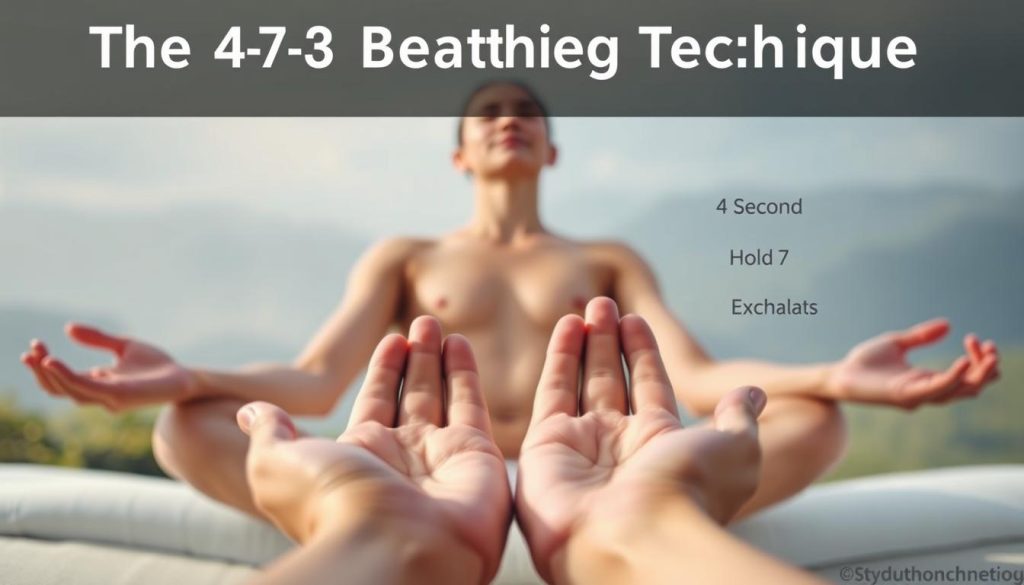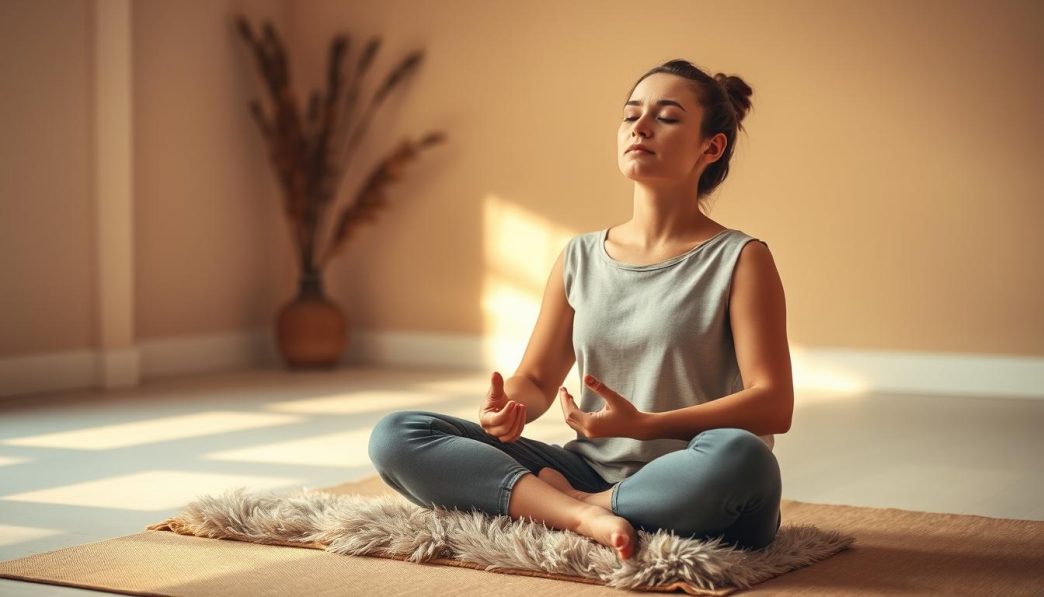In today’s fast-paced world, stress and anxiety can be overwhelming. Fortunately, there are simple yet effective ways to manage stress, and one of the most accessible methods is through breathing exercises for stress relief. These relaxation techniques can be practiced anywhere, making them a convenient tool for calming the mind and body.
By incorporating stress management techniques into your daily routine, you can reduce feelings of anxiety and improve your overall well-being. The best part is that these techniques require minimal time and effort, making them easy to fit into even the busiest schedule.
Key Takeaways
- Simple breathing exercises can help reduce stress and anxiety.
- Relaxation techniques can be practiced anywhere, anytime.
- Incorporating stress management into your daily routine can improve overall well-being.
- Minimal time and effort are required to practice these techniques.
- Breathing exercises can be a convenient tool for calming the mind and body.
The Science Behind Breathing and Stress Response
The connection between breathing and stress response is rooted in the complex workings of our nervous system. When we experience stress, our body’s “fight-or-flight” response is triggered, leading to rapid breathing and increased heart rate.
How Your Breath Affects Your Nervous System
Our breath has a direct impact on our nervous system. Conscious breathing can calm the nervous system, promoting relaxation and reducing stress. By controlling our breathing, we can influence our heart rate, blood pressure, and other physiological responses to stress.
The Fight-or-Flight Response and How Breathing Can Interrupt It
The fight-or-flight response is a natural reaction to stress, preparing our body to either confront or flee from danger. However, in modern times, this response is often triggered by non-life-threatening situations, leading to unnecessary anxiety. Deep, controlled breathing can interrupt this response, calming the mind and body.
The Vagus Nerve Connection
The vagus nerve plays a crucial role in regulating our heart rate, digestion, and other physiological processes. Breathing techniques can stimulate the vagus nerve, promoting relaxation and reducing stress. By activating the vagus nerve, we can enhance our body’s natural ability to calm down and recover from stress.
As Dr. Andrew Weil, a renowned expert in integrative medicine, notes, “Breathing is the key to unlocking the body’s natural relaxation response.” This underscores the importance of breathing techniques in managing stress and promoting overall well-being.
Why Controlled Breathing Is Your Secret Weapon Against Stress
By incorporating controlled breathing into daily routines, individuals can better manage stress. Controlled breathing techniques have been shown to have a positive impact on both physiological and psychological well-being.
Immediate Physiological Benefits
Controlled breathing can lead to immediate physiological benefits, including a decrease in heart rate and blood pressure. This can help alleviate the body’s stress response, promoting a sense of calm.
Long-Term Mental Health Advantages
Regular practice of controlled breathing can lead to long-term mental health advantages. It can reduce symptoms of anxiety and depression, improve mood, and enhance overall mental well-being.
What Science Says About Breathing Techniques
Research has demonstrated the effectiveness of breathing techniques in managing stress. Studies have shown that these techniques can alter the body’s stress response, leading to a decrease in cortisol levels and other stress markers.
| Breathing Technique | Benefits |
|---|---|
| Diaphragmatic Breathing | Reduces stress, improves lung capacity |
| Box Breathing | Enhances focus, calms the mind |
| 4-7-8 Breathing | Promotes relaxation, improves sleep |
By understanding the benefits and incorporating these techniques into daily life, individuals can harness the power of controlled breathing to manage stress effectively.
Stress-Busting Breathing Techniques You Can Do Anywhere
The beauty of stress-busting breathing techniques lies in their accessibility and ease of use. These techniques can be practiced anywhere, at any time, making them a valuable tool for managing stress in our daily lives.
What Makes These Techniques Accessible
One of the key advantages of stress-busting breathing techniques is that they require no special equipment or training. They can be done discreetly in a crowded office, during a commute, or even while waiting in line. This accessibility makes them an ideal solution for those looking to reduce stress on the go.
Moreover, these techniques are adaptable to different environments and situations, allowing individuals to tailor their practice to suit their needs. Whether you’re at work, at home, or traveling, you can easily incorporate breathing exercises into your daily routine.
When to Use These Techniques
Stress-busting breathing techniques are versatile and can be used in various situations. They are particularly effective during moments of high stress or anxiety, such as before a big presentation, during a hectic workday, or when feeling overwhelmed. Regular practice can also help prevent stress from building up in the first place.
Additionally, these techniques can be a great way to start or end the day on a positive note. Practicing breathing exercises in the morning can help set a calm tone for the day, while doing so in the evening can aid in unwinding before bed.
How to Incorporate Them Discreetly in Any Setting
Incorporating stress-busting breathing techniques into your daily life is surprisingly simple. You can practice them while sitting at your desk, standing in a crowded room, or even during a short break. The key is to be mindful of your breath and focus on the technique.
To do so discreetly, start by taking slow, deep breaths, focusing on the sensation of the air moving in and out of your body. You can also use a technique like box breathing or the 4-7-8 method, which can be done subtly without drawing attention to yourself.
Box Breathing: The Navy SEAL’s Secret Calm-Down Tool
Navy SEALs have long used box breathing as a secret weapon to stay calm under pressure, and it’s a technique you can use too. This method is called “box breathing” because it involves breathing in for a count of 4, holding for a count of 4, exhaling for a count of 4, and holding again for a count of 4, creating a “box” shape with your breath.
Step-by-Step Instructions
To practice box breathing, follow these simple steps:
- Find a comfortable and quiet place to sit or stand.
- Close your eyes and take a deep breath in through your nose for a count of 4.
- Hold your breath for a count of 4.
- Slowly exhale through your mouth for a count of 4.
- Hold your breath again for a count of 4.
Benefits and Applications
Box breathing offers numerous benefits, including reduced stress and anxiety, improved focus, and enhanced calmness. It’s a versatile technique that can be used in various situations, from high-pressure work environments to moments of personal stress.
| Benefits | Applications |
|---|---|
| Reduces stress and anxiety | Before a big presentation or meeting |
| Improves focus and concentration | During long periods of study or work |
| Enhances calmness and clarity | In moments of personal stress or anxiety |
Modifications for Beginners
For those new to box breathing, it’s okay to start with a shorter count and gradually increase as you become more comfortable with the technique. You can also practice it with your eyes open if closing them makes you feel uncomfortable.
By incorporating box breathing into your daily routine, you can develop a powerful tool to manage stress and enhance your overall well-being.
Diaphragmatic Breathing: Engaging Your Body’s Natural Relaxation Response
By mastering diaphragmatic breathing, you can tap into your body’s inherent ability to relax and unwind. Diaphragmatic breathing, also known as belly breathing, engages the diaphragm, the muscle that separates the chest and abdominal cavities, to facilitate a more efficient and relaxing breathing pattern.
Proper Technique and Posture
To practice diaphragmatic breathing correctly, start by adopting a comfortable posture, either sitting or lying down. Place one hand on your belly and the other on your chest. Inhale slowly through your nose, allowing your belly to rise as your diaphragm descends. Your chest should not move. Exhale slowly through your mouth, letting your belly fall as your diaphragm rises. This technique helps ensure that you’re using your diaphragm effectively.
Common Mistakes to Avoid
One common mistake is shallow chest breathing, which can lead to inadequate oxygenation and increased stress. Another error is tensing up or forcing the breath, which can be counterproductive. It’s essential to practice relaxation and allow your breath to flow naturally.
Tips for Effective Practice:
- Practice regularly to develop muscle memory.
- Start with short sessions and gradually increase duration.
- Use a timer or guided recordings to help you stay on track.
Progressive Practice Methods
As you become more comfortable with diaphragmatic breathing, you can explore progressive methods to deepen your practice. This might include increasing the length of your inhalations and exhalations, practicing in different positions, or incorporating visualization techniques.
| Practice Method | Description | Benefit |
|---|---|---|
| Increased Length | Gradually increase the duration of your breaths. | Enhances relaxation and reduces stress. |
| Positional Variation | Practice diaphragmatic breathing in different positions. | Improves flexibility and adaptability. |
| Visualization | Incorporate visualization techniques during breathing. | Promotes mental calm and focus. |
By incorporating diaphragmatic breathing into your daily routine, you can harness your body’s natural relaxation response, leading to a more balanced and peaceful life.
4-7-8 Breathing: The Natural Tranquilizer for Anxiety
For those seeking a natural approach to managing anxiety, the 4-7-8 breathing technique offers a promising solution. This method, also known as the “Relaxation Breath,” has been popularized by Dr. Andrew Weil and is rooted in ancient yogic practices.
Origins and Development
The 4-7-8 breathing technique has its roots in the ancient practice of Pranayama, a yogic breathing exercise. Dr. Andrew Weil, a renowned integrative medicine expert, popularized this specific technique as a tool for promoting relaxation and reducing stress.
How to Practice Correctly
To practice the 4-7-8 breathing technique correctly, follow these steps:
- Find a comfortable seated position with your back straight.
- Close your eyes and inhale through your nose for a count of 4.
- Hold your breath for a count of 7.
- Exhale through your mouth for a count of 8.
This cycle can be repeated up to three times, ideally twice a day.
Ideal Situations for This Technique
The 4-7-8 breathing technique is particularly useful in situations that trigger anxiety, such as before a big presentation or during stressful events. It can also be a valuable tool for improving sleep quality by promoting relaxation before bedtime.

By incorporating the 4-7-8 breathing technique into your daily routine, you can potentially reduce anxiety and improve overall well-being. This natural tranquilizer offers a simple yet effective way to calm the mind and body, making it an invaluable tool for anxiety relief.
Beyond the Basics: Advanced Breathing Techniques
To further enhance your stress-busting arsenal, consider incorporating advanced breathing techniques into your daily routine. These sophisticated methods can help you achieve a deeper state of relaxation and improve your overall well-being.
Alternate Nostril Breathing (Nadi Shodhana)
Alternate Nostril Breathing, also known as Nadi Shodhana, is a yogic breathing technique that balances the breath and calms the nervous system. To practice, close one nostril with your finger and inhale through the other. Then, switch and exhale through the other nostril. This technique is known for its ability to reduce stress and improve respiratory function.
Coherent Breathing
Coherent Breathing involves breathing at a rate of 5-7 breaths per minute, which is believed to synchronize your heart rate and breathing, promoting a state of coherence. This technique can help reduce stress and anxiety by creating a harmonious balance between your body’s physiological processes.
Lion’s Breath (Simhasana)
Lion’s Breath, or Simhasana, is a powerful breathing technique that involves exhaling forcefully through the mouth, accompanied by a “ha” sound. This technique can help release tension and stress, promoting a sense of calm and relaxation.
Breath Counting Meditation
Breath Counting Meditation involves focusing on your breath while counting each inhalation and exhalation. This technique can help calm the mind and reduce stress by promoting mindfulness and concentration.
As you explore these advanced breathing techniques, remember to practice regularly to experience their full benefits. With consistent practice, you can enhance your ability to manage stress and promote overall well-being.
Breathing Techniques for Specific Stressful Situations
Breathing techniques offer a versatile toolkit for tackling various stressful situations. By mastering the right technique for the moment, you can significantly reduce your stress levels and improve your overall well-being.
Before Public Speaking or Presentations
Before a big presentation or public speaking engagement, box breathing can be particularly effective. This technique helps calm the nerves and focus your mind. To practice box breathing, inhale for a count of 4, hold your breath for a count of 4, exhale for a count of 4, and hold again for a count of 4. As Dr. Andrew Weil suggests, “This type of breathing can help you regain control over your body’s response to stress.”
During Work Stress or Deadlines
During intense work periods or when facing tight deadlines, diaphragmatic breathing can help manage stress. This technique engages your diaphragm, promoting full oxygen exchange and a sense of calm. To practice, place one hand on your belly and the other on your chest. Inhale deeply through your nose, allowing your belly to rise while your chest remains still. As you exhale, your belly should fall. According to a study, “Regular diaphragmatic breathing can reduce stress and anxiety.”

For Sleep and Insomnia
For individuals struggling with sleep or insomnia, the 4-7-8 breathing technique can be a natural tranquilizer. Also known as the “relaxation breath,” this technique involves inhaling through your nose for a count of 4, holding your breath for a count of 7, and exhaling through your mouth for a count of 8. As
“This method has helped many individuals fall asleep faster and sleep more soundly,”
notes a sleep specialist.
During Panic or Anxiety Attacks
During panic or anxiety attacks, coherent breathing can provide immediate relief. This involves breathing at a rate of 5 breaths per minute, which can help synchronize your heart rate and calm your nervous system. To practice, inhale for a count of 5 and exhale for a count of 5. As one study found, “Coherent breathing can significantly reduce symptoms of anxiety and panic.”
By incorporating these breathing techniques into your daily life, you can develop a robust defense against stress, improving your ability to handle challenging situations with calm and composure.
Tech Support: Apps and Tools for Breathing Practice
With the help of modern technology, you can now easily track and improve your breathing exercises. Various technological tools are available to support your practice, from mobile apps to wearable devices and online communities.
Top Breathing Apps for Beginners
For those new to breathing exercises, apps can be a great starting point. Some of the top-rated apps include:
- Headspace: Offers guided breathing exercises and meditation sessions.
- Calm: Features a variety of breathing exercises and sleep stories.
- Breathwrk: Provides customizable breathing exercises tailored to your needs.
Wearable Devices That Monitor Breathing
Wearable devices can track your breathing patterns and provide valuable insights. Some popular options are:
| Device | Features |
|---|---|
| Fitbit | Tracks breathing rate and offers guided breathing sessions. |
| Apple Watch | Monitors breathing rate and integrates with the Breathe app. |
| Oura Ring | Tracks breathing patterns during sleep and provides detailed reports. |
Online Resources and Communities
Joining online communities can enhance your breathing practice by providing support and additional resources. Some notable platforms include:
- Reddit: Communities like r/Meditation and r/BreathingExercises share tips and experiences.
- Online Forums: Websites dedicated to mindfulness and breathing exercises often have forums for discussion.
By leveraging these technological tools, you can enhance your breathing practice and better manage stress.
Conclusion: Your Breath Is Always With You
As we’ve explored throughout this article, your breath is a powerful tool for managing stress. By incorporating simple yet effective breathing techniques into your daily life, you can significantly reduce anxiety and improve your overall well-being.
Breath awareness is always available to you, providing a constant sense of calm and control. Whether you’re facing a stressful situation or simply need to unwind, the techniques discussed can be applied discreetly in any setting.
In summary, mastering stress management through breathing techniques can lead to a more balanced and peaceful life. By practicing these methods regularly, you’ll be better equipped to handle life’s challenges with clarity and composure.
Take the first step today by choosing a technique that resonates with you, and start experiencing the benefits of conscious breathing.






